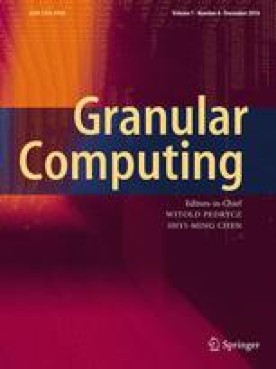期刊简介
Journal Title:Granular Computing
Granular Computing is an international academic journal dedicated to the field of granular computing. It is a new concept and computational paradigm in information processing that involves the study of all theories, methods, techniques, and tools related to granularity. As a superset of fuzzy logic, rough set theory, quotient space theory, and interval computation, granular computing plays an important role in handling fuzzy, incomplete, imprecise, and massive information, and is one of the hotspots in the field of artificial intelligence research. The purpose of this journal is to publish the latest research results in granular computing and related fields, including theoretical development, algorithm design, and application case studies. Through these studies, the journal aims to promote scientific progress in the field of granular computing and provide a platform for academia and industry to exchange the latest research findings. The importance of magazines lies in their potential contribution to enhancing data processing capabilities, optimizing decision-making processes, and promoting the development of intelligent systems.
The magazine covers a wide range of research areas, including but not limited to theoretical research on multi-level granularity structures, the establishment of granularity computing models, and the application of these theories and models in various practical problems. The journal encourages interdisciplinary research, especially those that can reveal new principles of granular computing or improve existing algorithms. In addition, the journal also focuses on the integration of granular computing with other computing paradigms such as machine learning, data mining, and cognitive science.
中文简介
《粒度计算》是一本专注于粒度计算领域的国际学术期刊。它是信息处理的一种新概念和计算范式,它涉及到所有有关粒度的理论、方法、技术和工具的研究。作为模糊逻辑、粗糙集理论、商空间理论和区间计算等的超集,粒度计算在处理模糊、不完整、不精确及海量信息方面发挥着重要作用,并且是人工智能研究领域的热点之一。该期刊的目的在于发表粒度计算及其相关领域的最新研究成果,包括理论发展、算法设计、应用案例研究等。通过这些研究,期刊旨在推动粒度计算领域的科学进展,为学术界和工业界提供一个交流最新研究成果的平台。杂志的重要性体现在其对于提升数据处理能力、优化决策过程和促进智能系统发展的潜在贡献。
杂志涵盖了广泛的研究范围,包括但不限于多层次粒度结构的理论研究、粒度计算模型的建立、以及这些理论和模型在各种实际问题中的应用。期刊鼓励跨学科的研究,特别是那些能够揭示新的粒度计算原理或改进现有算法的工作。此外,期刊还关注粒度计算与其他计算范式的结合,如机器学习、数据挖掘和认知科学等。
期刊点评
Granular Computing由Springer Nature出版商出版,收稿方向涵盖Multiple全领域,平均审稿速度 ,该期刊近期被列入国际期刊预警名单,请广大学者慎重选择。
WOS分区(数据版本:2023-2024年最新版)
| 按JIF指标学科分区 | 收录子集 | 分区 | 排名 | 百分位 |
| 学科:COMPUTER SCIENCE, ARTIFICIAL INTELLIGENCE | ESCI | N/A | N / A |
0% |
| 学科:COMPUTER SCIENCE, INFORMATION SYSTEMS | ESCI | N/A | N / A |
0% |
| 按JCI指标学科分区 | 收录子集 | 分区 | 排名 | 百分位 |
| 学科:COMPUTER SCIENCE, ARTIFICIAL INTELLIGENCE | ESCI | Q1 | 29 / 198 |
85.61% |
| 学科:COMPUTER SCIENCE, INFORMATION SYSTEMS | ESCI | Q1 | 30 / 251 |
88.25% |
名词解释:
WOS即Web of Science,是全球获取学术信息的重要数据库,Web of Science包括自然科学、社会科学、艺术与人文领域的信息,来自全世界近9,000种最负盛名的高影响力研究期刊及12,000多种学术会议多学科内容。给期刊分区时会按照某一个学科领域划分,根据这一学科所有按照影响因子数值降序排名,然后平均分成4等份,期刊影响因子值高的就会在高分区中,最后的划分结果分别是Q1,Q2,Q3,Q4,Q1代表质量最高。
CiteScore分区(数据版本:2024年最新版)
| CiteScore | SJR | SNIP | CiteScore排名 | ||||||||||||||||
| 10.7 | 1.415 | 1.737 |
|
名词解释:
CiteScore:衡量期刊所发表文献的平均受引用次数。
SJR:SCImago 期刊等级衡量经过加权后的期刊受引用次数。引用次数的加权值由施引期刊的学科领域和声望 (SJR) 决定。
SNIP:每篇文章中来源出版物的标准化影响将实际受引用情况对照期刊所属学科领域中预期的受引用情况进行衡量。
其他数据
| 是否OA开放访问: | h-index: | 年文章数: |
| 未开放 | -- | 60 |
| Gold OA文章占比: | 2021-2022最新影响因子(数据来源于搜索引擎): | 开源占比(OA被引用占比): |
| 5.53% | 0 | |
| 研究类文章占比:文章 ÷(文章 + 综述) | 期刊收录: | 中科院《国际期刊预警名单(试行)》名单: |
| 81.67% | SCIE | 是 |
历年IF值(影响因子):
历年引文指标和发文量:
历年自引数据:
发文统计
更多问题
免责声明
若用户需要出版服务,请联系出版商。
